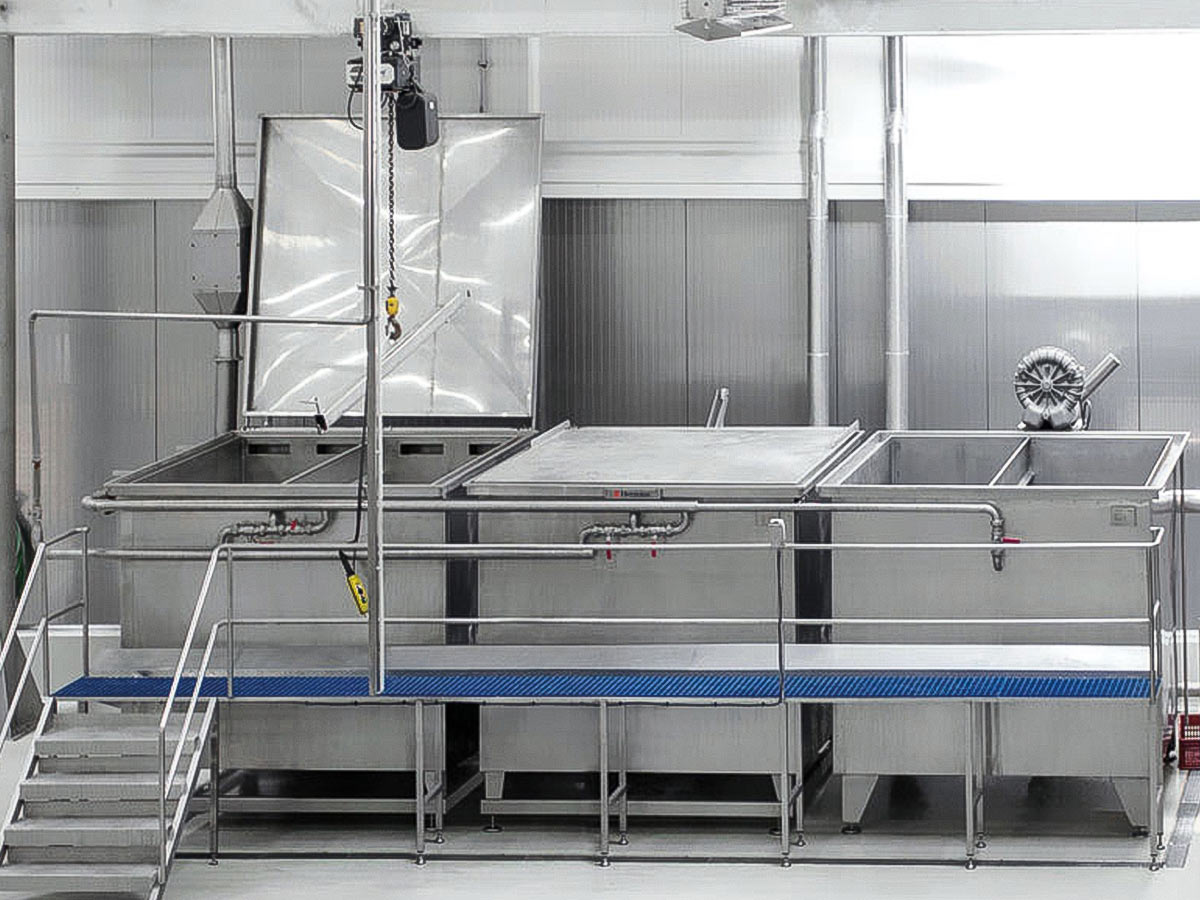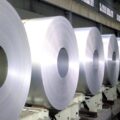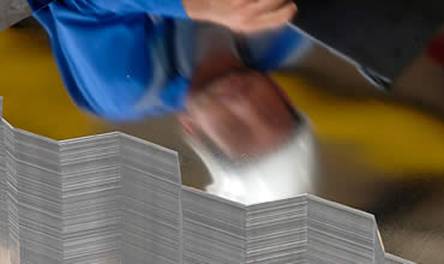Steel Production
The tinplate production process begins in the blast furnace and tin smelter, although in practice, it is considered to start with the production of the base steel.

Base Steel Fabrication
Base steel is the body and essence of tinplate, determining its final properties. Base steelmaking is a process that begins with obtaining raw steel in liquid form from two basic processes: using iron ore or recycled scrap.
A. Iron Ore Smelting Process: In this method, iron ore is subjected to a smelting process to obtain liquid steel. The quality of the steel depends on the composition and cleanliness achieved during this process.
B. Process from Scrap: Scrap is also used as raw material for steel production. In fact, all tinplate packaging contains a percentage of recycled material, demonstrating the industry’s commitment to sustainability and the circular economy.
Base Steel Composition: The composition of the base steel is a critical factor that is decided at the time of fabrication, defining its future use as a rolled product. The base steel used in the manufacture of tinplate is of the low carbon type, with a carbon content ranging from 0.03% to 0.13%. This steel usually comes in sheets between 5 and 20 meters long, with a width of slightly more than one meter and a thickness of 20 cm.
Hot Rolling of Tinplate
Hot Rolling ProcessStages
Heating: Hot rolling starts with the heating of the steel slabs in furnaces. This heating is essential to achieve the necessary malleability in the steel, allowing its subsequent deformation. The heating temperature ranges from 1150 °C to 1250 °C, and strict control of the furnace temperature and atmosphere is crucial to ensure the surface quality of the finished product.
Roughing: In this phase, a preliminary reduction of the steel thickness is carried out. A roughing train is used, which can reduce the initial plate thickness by 25% to 50% per box. Rolling at this stage is carried out in the austenitic phase, where both roughing and finishing are performed at high temperature. However, this phase presents challenges in terms of productivity and material quality.
Finishing: The material then passes to the finishing mill, which consists of several boxes that further reduce the thickness of the steel. Subsequent reductions can vary between 25% and 30%, except in the last box, which makes a reduction of approximately 10%. The finishing temperature is approximately 800 °C to 900 °C, and is controlled by water quenching.
Cooling and Winding: After finishing, the material is cooled to temperatures of 500 °C to 700 °C and then wound. The objective of this stage is to obtain coils of determined dimensions, ready for the next manufacturing process.

Pickling in Tinplate.
What is pickling?
Pickling is a chemical treatment applied to steel sheets to remove impurities, oxides and scale that have formed on the surface of the metal during previous processes, such as hot rolling. The presence of these impurities can adversely affect the quality of the subsequent coating and the formability of the material.

Pickling Process in Tinplate Production
Preparation: Before pickling, the steel coils are uncoiled and cut.
Immersion in Acid Baths: The sheets are immersed in acid baths, commonly hydrochloric acid or sulfuric acid, which dissolve and remove the oxide layer.
Washing: After acid treatment, the sheets are washed with water to remove acid residues and prevent future corrosion.
Drying: The sheets are dried to remove any remaining moisture that may affect subsequent stages, such as cold rolling.
Quality Control in Pickling
Quality control is crucial in the pickling process. Several parameters must be monitored to ensure that the steel surface is clean and ready for cold rolling and tin coating:
Acid Concentration: The acid concentration in the baths is controlled to ensure efficient oxide removal without damaging the base metal.
Immersion Time: The immersion time is adjusted to ensure that the entire surface is adequately treated.
Bath Temperature: An optimum temperature is maintained to maximize the efficiency of the pickling process.
Cold Rolling.
Process Goal
The main objective of cold rolling is to obtain a uniform and precise tinplate thickness, suitable for the production of metal packaging. This process not only reduces the thickness but also improves the mechanical properties and the surface of the material.

Process Description
During cold rolling, the steel strip is passed through a series of rolls at room temperature. The pressure exerted by the rollers reduces the thickness of the strip without heating it. This process increases the strength and hardness of the steel, while improving the surface quality, which is essential for the subsequent application of coatings and to ensure good printing quality on packaging.
Advantages of Cold Rolling
Improved Mechanical Properties: Increases the tensile strength and hardness of the material, which is beneficial for handling and forming containers.
Uniform Surface: Provides a smooth, uniform surface that is ideal for coating application and high quality printing.
Thickness Accuracy: Allows precise control of material thickness, which is critical for the standardization of metal packaging.
Annealing and Heat Treatment of Metals
Its main objective is to restore ductility to steel after the cold rolling process, through the recrystallization of the material. There are two predominant annealing methods: Batch Annealing (BA) and Continuous Annealing (CA).
Bell Annealing (BA)
Bell annealing is a batch process carried out by heating several coils stacked under a bell in a reducing atmosphere at a temperature of 680°C for a prolonged time, which can reach at least 85 hours. This process is divided into stages of heating, temperature maintenance and cooling under a hood followed by accelerated cooling in the open air.
In terms of mechanical properties, bell annealing tends to produce a steel with a lower yield strength and higher elongation, which translates into better ductility. This type of steel is preferred for applications that require a higher deformation capacity without fracture, such as deep drawing.
Continuous Annealing (CA)
On the other hand, continuous annealing involves heating the steel strip circulating through an oven at a temperature of 630°C, where each spot of material remains for at least 1.5 minutes. This process is integrated and continuous, and offers several advantages such as reduction of in-process materials and lead times.
Continuously annealed steel usually has a higher yield strength and lower elongation compared to BA, as well as a lower tendency to lug. This is because the rapid annealing cycle promotes the formation of fine equiaxial grains, resulting in a more isotropic metal with superior mechanical properties. In addition, AC improves corrosion resistance by not allowing elements such as carbon and manganese to migrate to the surface of the material.
Tinplate Tempering in the Manufacture of Metal Packaging
This heat treatment adjusts the mechanical properties of tinplate to obtain the appropriate hardness and malleability.
The Tempering Process
Tempering is performed after annealing, where the steel strip has lost its hardness and needs to be adjusted to the values required for forming into containers. This process consists of one or two roller boxes where the strip receives a soft, dry lamination, which slightly reduces its thickness (less than 2%) and at the same time improves the surface and reinforces its flatness.
Tempering trains
Higher power tempering trains with the use of lubricants (wet) allow a more precise control of the process. The steel strip is subjected to controlled tension as it passes through the rollers, adjusting its hardness and surface texture. This step is essential to ensure print quality and varnish adhesion at later stages.
Tempering Objectives
Hardness Adjustment: The main objective of tempering is to adjust the hardness of tinplate to the values necessary for its handling and forming into metal containers.
Surface Enhancement: Tempering refines the surface of the tinplate, which is crucial for print quality and adhesion of protective coatings.
Flatness Control: A flat web is essential for efficiency in container production lines and to avoid defects during container forming.
Technical Considerations
Tension Control: It is essential to maintain a uniform tension in the web during tempering to avoid the formation of wrinkles or residual tensions.
Lubrication: The use of lubricants in wet tempering helps to protect the tinplate surface and improve the quality of the finish.
Temperature and Speed: Temperature and belt speed must be controlled to ensure process uniformity.
Electrolytic Tin Plating
What is Electrolytic Tin?
Electrolytic tin plating is a coating technique that uses a tin-rich electrolyte to deposit a layer of tin on the surface of tinplate.
Electrolytic Tin Plating Process
The electrolytic tin plating process begins with the preparation of the steel strip, which must be clean and free of oxides. Once prepared, the strip is immersed in an electrolytic bath containing tin ions. When an electric current is applied, tin ions are deposited on the surface of the steel, forming a uniform layer.

Advantages of Electrolytic Tinplate
Corrosion Protection: Electrolytic tinplate provides an effective barrier against corrosion, which is essential for the preservation of food and other packaged products.Attractive Appearance: Electrolytic tinplate has a shiny and aesthetically pleasing surface, which is important for product presentation.
Improved Solderability: The tin coating improves the solderability of the steel, facilitating the manufacture of high quality containers.
Coating Thickness Control: The process allows precise control of the tin coating thickness, resulting in a more efficient use of the material and the possibility of adapting the product to different applications.
Tinplate Passivation
What is Passivation?
Passivation is a treatment applied to the surface of tinplate to form an oxide layer that protects the steel from corrosive processes. The methods for achieving this protective coating can be chemical or electrochemical, and are designed to give the material special characteristics.
Types of Passivation Solutions
Passivation 300: It is obtained by a chemical process, by immersion in sodium dichromate solution, generating a chromium oxide layer. It offers good adhesion of the varnish and weak protection against sulfidation, although it is unstable and its effectiveness is reduced with time.
Passivation 311: This is the most widely used and is obtained by an electrochemical process. A layer of chromium and chromium oxide is electrolytically deposited in a sodium dichromate bath. This passivation is desirable from a performance point of view.
Functions and Benefits of Passivation
Passivation provides protection against external agents that can damage tinplate during manufacture or in subsequent operations. In addition, it improves the surface chemically for lithography and varnishing processes, and provides a certain protective hardness.

Protection against sulfidation
Passivation, especially type 311 due to its composition, prevents tin sulfide staining. However, for optimum protection against this risk, the varnish plays a crucial role by creating a physical and chemical barrier that protects the product.
Oiling
Oiling is an essential process carried out on the surface of cans to ensure their correct sliding during manufacture and transport.
DOS Oil: Dioctyl Sebacate
The oil used in this process is known as DOS, an acronym for Dioctyl Sebacate. This oil is selected for its non-reactive properties and its compatibility with food packaging processes, complying with FDA and USDA regulations. In addition, DOS provides a protective film that prevents direct contact of the metal with other objects, thus reducing the risk of abrasions and scratches.
Application of DOS Oil
DOS oil is applied by rollers or spraying systems, a thin and uniform layer of oil is distributed over the entire surface of the can.















